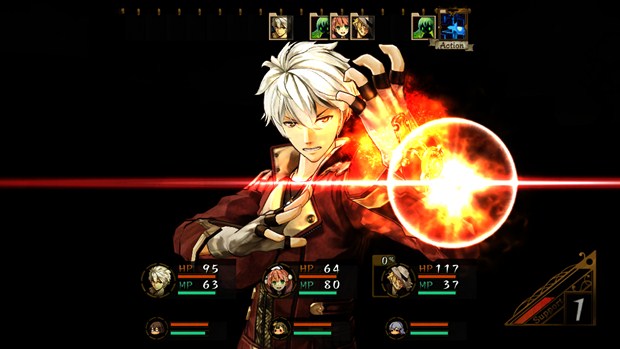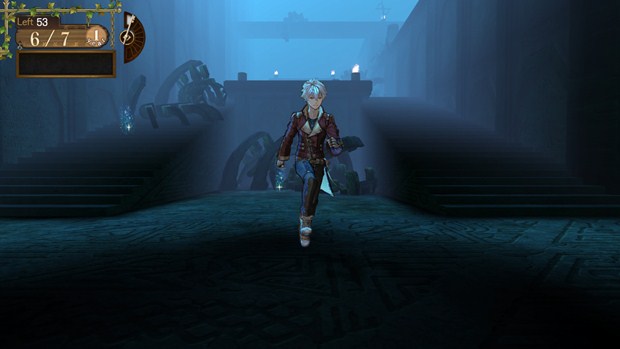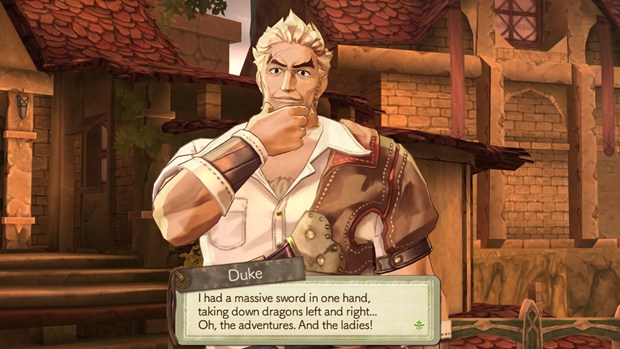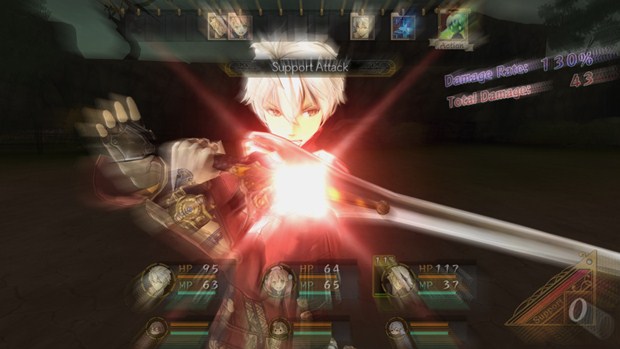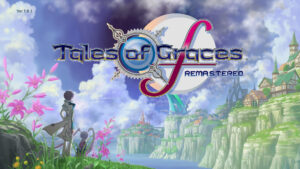
Charming characters with personality in depth is what Atelier Escha & Logy is all about and this is what had hooked me the most. Being able to achieve this feat within the duration of ten minutes of doing so with the most minimal amount of actual playtime is what makes this game so great, and this feeling of excitement and caring about the characters is what gives the game strength.
The game’s main story plays out like something of an interactive novel, it carries a real feeling of grandeur and richness to it that makes you want to see it through to the end. Atelier Escha & Logy tells the story of a small town located far off in the middle of nowhere, well away from the big city that the game mentions during character interaction. This town known as Colseit is at the heart of what is essentially a monster breeding ground and because of this the town suffers continous attacks and therefore is living life like a survivalist state. The Governments R&D department responsible for the well-being and survival of its people, appoints the town’s local Alchemist in-training named Escha, to work alongside a more skilled and darker Alchemist who has been recruited from the big city, Logy.
"The game's amazing way of connecting the characters own personal stages of learning and progression to that of the player's experience with the game itself adds to the overall immersion of being one with the characters. This is also extended to other parts of the game such as the gameplay and crafting features, as well as the enemy encounters."
As both play the role of main character, the game offers the choice as to whom the player will experience the adventure as well as keeping the other relevant. Playing through the game as Escha appoints Logy as a secondary character who you will also play during enemy battles through the means of a party system. Choosing to go along with Logy rather than Escha switches the roles of the two characters in a similar fashion.
The only differences that come from playing as one over the other is rooted in their own personal background history and that off their own unique play styles. Where the game sets Logy up as a newcomer from out of town who has journeyed from a more modernized city to work alongside Escha, his play style and attacks reflect this with a more up to date way of doing so which favors the modern technology. This is also reflected in dialogue and his personality.
Escha on the other hand who as we know grew up in Colseit is more traditional in her use of alchemy and her everyday life. Later on in the game when the player is introduced to the use of the cauldron, Logy’s surprise to this older way of practicing alchemy leaves him in a bit of a pickle as he’s not familiar with this method of doing things. Playing as Escha during this section, Logy’s role as the secondary character is enhanced as he takes more of an assistant stance during the time being.
The game’s amazing way of connecting the characters own personal stages of learning and progression to that of the player’s experience with the game itself adds to the overall immersion of being one with the characters. This is also extended to other parts of the game such as the gameplay and crafting features, as well as the enemy encounters.
"The Atelier itself works in two ways. As a hub base for both Escha and Logy to create items from alchemy and work together via the game's narrative. The second use is directed more towards the player's control and use of the two characters through item crafting, resting, saving and loading the game."
Earlier sections of the game present a funny way of masking it’s own limits on just how much of its world is available to you. Character dialogue progress the game’s narrative forward and opens up mini sections of its world to deliver the impression of exploration and free-will in which you can wonder about the town and the outerlands.
While the feeling of exploration and freedom is welcome particularly in a game that consists of so much cut-scenes for its character interaction,the ten seconds it takes to move from each mini segment of the game’s world, along with its non-interactive objects and minimal interaction from NPCs contradict this purpose. As the majority of the game is progressed through listening to character dialogue and text bubbles, there’s nothing more required to do, other than repeatedily press the X button to move along the character’s conversations.
While this is necessary to meet other characters of the world such as Marion, Duke, and Escha’s brother Awin, the weird feeling of being in a world which felt to deliver on some form of exploration while providing none was a deal breaker. A fast travel system using the game’s world map also plays a role in this odd sense of traveling, as it completely eradicates the need for venturing the small bland areas that the game gives you other than for the use of enemy encounters. I would like to say these miniature areas of the game are here for the feeling of immersion and an environment that’s truly alive and pulls you into its world, but since nothing ever takes place here I had to question its purpose.
The Atelier itself works in two ways. As a hub base for both Escha and Logy to create items from alchemy and work together via the game’s narrative. The second use is directed more towards the player’s control and use of the two characters through item crafting, resting, saving and loading the game. Mission objectives and progression is monitored and completed on the basis of an in-game monthly timer. During this timer the player needs to complete a main mission with minor side quests. This ties directly into the characters duty of working at R&D in the game’s storyline.
"Getting to know which item works best with what and how its various effects will play out is largely down to paying attention, being persistent, and remaining patient. As much as the tutorial stages of the game will have you think this is a simple action it's really not and requires some learning."
As the character’s get paid for completing their assignments it’s up to the player to use this payment for the beneficial needs of his or her character, and how they can better themselves with items and new objects for up coming assignments. This player to character connection ties itself well to the feeling of immersion. Along with Escha’s forgetfulness to keep track with what’s being explained of the mission criteria and in-game mechanics, Logy’s witty-thinking of carrying a notepad feeds directly back into the player’s game objectives on the pause menu.
Another handy feature which was tuned more to its gameplay through the means of item crafting was the use of Homunculi. These small creatures work alongside the characters in the game to recreate any item previously used. This shortens the time as to pose to starting from scratch. Crafting items first time around works on a similar scale to most games that involve this feature. Meet the required level, use the right combination, and hope for the best. Getting to know which item works best with what and how its various effects will play out is largely down to paying attention, being persistent, and remaining patient. As much as the tutorial stages of the game will have you think this is a simple action it’s really not and requires some learning.
Gathering items is achieved by stumbling across them in the world as small as it is and defeating the monsters within the game. That’s right, monsters, did you forget? What did you think these abilities of alchemy where being used for, a cooking show? As your reason for existence in the game is driven by the need to protect your town from invading monsters using your abilities of alchemy, getting to grips with its combat system is crucial, otherwise you have no purpose.
"Combat is played out through the form of turn-based attacks with each member of your party moving in one after another with set timers. Along with bareback attack methods you also have the option to call in support during the attack, or equip items and wait for your turn."
Combat is played out through the form of turn-based attacks with each member of your party moving in one after another with set timers. Along with bareback attack methods you also have the option to call in support during the attack, or equip items and wait for your turn. Combat also involves party on party battles whereby one enemy may come across you in the game but may open itself up to a party of three.
This is why preparation is important to the game and where item crafting plays a crucial role in leveling up your characters. Battles are completed in one of two ways, successfully runaway like a coward and live to run another day, or fight your opponent till its health is no more. Losing a battle however will take a toll on your overall mission progression and will set you back one day to rest.
One major problem I experienced with the game occurred directly after familiarizing myself with its mechanics and actually getting a handle on how to play this game. It was also one of the main reasons I enjoyed it as well. With each character I met during my first hour of the game there was a large amount of personality and attitude that although remained static through character animation, still carried a feeling of being distinct and lively from one another when engaging in character conversation.
The game breaking bug which followed shortly after in which their lips would move but nothing would come out completely broke the game for me. It was as if real human dialogue was recorded up until that point during the game’s development and someone in the sound department switched off the Mic.
"Visuals present themselves as something of a mixed bag. The game's background environment being rendered in 3D while those of characters are somewhere between Borderlands and traditionally drawn anime deliver a weird contrast."
Visuals present themselves as something of a mixed bag. The game’s background environment being rendered in 3D while those of characters are somewhere between Borderlands and traditionally drawn anime deliver a weird contrast. This extends into the game’s cut-scenes where the stiff and minimal animations of the characters manage to look bland and false, even against the game’s environment which is for the most part a rigid and lifeless set-piece.
Being able to play as two very different characters offers up extraordinary replay value. As the two characters are largely different in the roles they play, whether it’s a primary one through the player or as a secondary one assisting the player, there’s a fine balance between them that stops the game from going stale and casting off the latter character as an unwanted annoyance. This feeling of actual life and usefulness that the secondary character brings to you aids the game’s narrative and the interaction between other characters within the game.
With no online component or local two-player co-op this solo journey of becoming one with the characters and following them through this ten-hour plus journey is a great one indeed. Neither of the two felt necessary and all in all Atlier Escha and Logy is a great game. The discoverabilty and enriching world the game provides leaves you satisfied, with a curious feeling as to what future titles in the series may entail.
This game was reviewed on the PlayStation 3.
Lovable characters and replay value that actually makes sense.
Audio problems and a hand-holding help system that overstayed its welcome.









